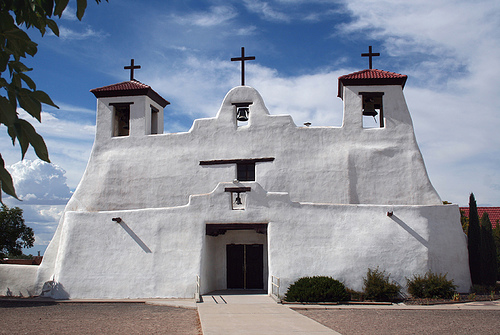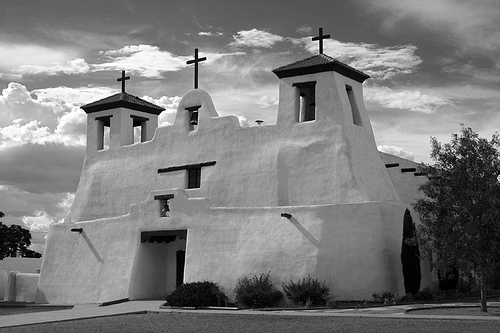 |
Canku Ota
|
 |
|
(Many Paths)
|
||
|
An Online Newsletter
Celebrating Native America
|
||
|
January 1, 2009 - Volume
7 Number 1
|
||
|
|
||
|
Isleta Church Shows
Beauty of its 300 Years
|
||
|
by Clara Garcia Valencia
County (NM) News-Bulletin Staff Writer; cgarcia@news-bulletin.com
|
||
|
credits: photos courtesy
of David Bales
|
|
That light comes from a single window shining brightly on the crucifix hanging above the altar. It's a magical and mesmerizing sight, knowing that the building you're standing in is more than 300 years old — filled with memories of generations upon generations of people who have faithfully worshiped within its walls. The church, which is one of the oldest in the state, has gone through numerous renovations and rebuilds, probably more than any other church in New Mexico. According to Father Hilare Valiquette, the pastor at Saint Augustine, the whole pueblo was built after the Spanish returned to the area in 1692 after the Pueblo Revolt, and the adobe church was erected around 1700. Saint Augustine was among four historic Valencia County places of worship featured in a day-long historic church tour sponsored recently by the Los Lunas Museum of Heritage and Art. "The paintings in the church are all from Mexico, except for one wood painting in the northeast side of the church that was probably from Flanders in the 15th century, and no one knows how it got here," Valiquette said. "We just finished a study of all the artwork and the artifacts, and because they've suffered a lot of damage over the years, the restoration would be about $15,000 per painting." Frances Abeita, chairman of the church's finance committee, said most of the paintings were painted on deer hide and elk skin and have been damaged by people who tried to polish them with oil.
Valiquette explained that a study on the building's structure has recently been completed and the tribe is committed to fix the problem, which could cost more than $2.5 million. The churches in the Native American pueblos in New Mexico don't belong to the Catholic Archdiocese of Santa Fe, but rather to the tribe. All the concrete on the towers, the roof, the parapets on the side and on all of the structural elements will have to be removed in five-foot squares, one at a time, Valiquette said. He said if they took all the concrete off at one time, the entire church could collapse. "From
earlier pictures, we can see that additions were made inside to
the balcony that had a roof above it," Valiquette said. "The
French priest that was here at the time decided to turn it into
a French piece of cake with a hip roof and strange towers on it.
In the '50s, the roof and towers were removed and California mission-type
towers were put on." One thing that has never changed since the church was first built — the light that shines down on a crucifix hanging above the altar. Abeita said the only light in the entire church was from that one small window. "All the services were held during the day because that was the only light in the church," she said of the early days of the church. "It took a lot of hard work to bring in the vigas for the church. They were actually brought down by oxen from the mountains." She said the men of the church cut and carved vigas by hand with simple small knives. The adobe walls inside the church are about 10 feet wide at the bottom and become narrower toward the top. "At the time the church was built in the 1600s, there was nothing to keep the structure from falling down, and that's why they built it like this — wide at the bottom and narrow at the top," she said. About 10 years ago, there was a fire in the church's choir loft, the damage of which hasn't yet been repaired. Abeita said a candleholder underneath the loft somehow toppled over and caused the fire. "Luckily, someone was here or else we would have lost the whole church," she said. "The choir still uses the loft, but it's still not the safest place because of the structural damage." With about 5,000 tribal members in Isleta, there are about 500 active members at Saint Augustine. Abeita said the tribe is 90 percent Catholic. While most of the elders in Isleta still speak fluent Tiwa, the traditional language of the Isletans, Abeita said she's afraid it has become lost among the pueblo's youth. "We do have Tiwa classes at two places — at the school and another place on Highway 47, but we've lost our language because our young children don't practice it as much as they should," she said. "We need to keep up our language because that's the only way our traditions will hold." While the Tiwa language may be in danger, Abeita says the pueblo works hard in making sure its culture and traditions continue. The prayers that they pray are the same as they prayed hundreds of years ago. Even through this modern era, the people's faith and religion continues to hold strong. Along with the history of Saint Augustine, there are also many folk tales of strange happenings involving the spirit of a priest who is buried underneath the altar in the church. Abeita said every couple of years; the coffin would rise from below, scaring a lot of the parishioners. "They think now that it was erosion," she said. "The last time they put it back in the ground, they covered it with cement — just in case." One of the most anticipated events of the year at Saint Augustine Catholic Church in Isleta is during the Christmas season. There is a Mass, of course, on Christmas Eve, including traditional native dancing inside. On Christmas Day, and three days following, Valiquette said, the public is invited to spend the day at the church watching the dancers who perform outside. |
|
insert map here
|
www.expedia.com |
|
|
||
|
|
||
| Canku Ota is a free Newsletter celebrating Native America, its traditions and accomplishments . We do not provide subscriber or visitor names to anyone. Some articles presented in Canku Ota may contain copyright material. We have received appropriate permissions for republishing any articles. Material appearing here is distributed without profit or monetary gain to those who have expressed an interest. This is in accordance with Title 17 U.S.C. Section 107. | ||
|
Canku Ota is a copyright ©
2000, 2001, 2002, 2003, 2004, 2005, 2006, 2007, 2008, 2009 of Vicki
Barry and Paul Barry.
|
||
 |
 |
|
|
The "Canku
Ota - A Newsletter Celebrating Native America" web site and
its design is the
|
||
|
Copyright ©
1999, 2000, 2001, 2002, 2003, 2004, 2005,
2006, 2007, 2008 of Paul C.
Barry.
|
||
|
All Rights Reserved.
|
||
 Isleta,
NM - When you first walk through the doors of the historic Saint
Augustine Catholic Church in Isleta, your eyes automatically follow
the light.
Isleta,
NM - When you first walk through the doors of the historic Saint
Augustine Catholic Church in Isleta, your eyes automatically follow
the light. Throughout
the years, members continued their best to restore the church. At
one point, parishioners got tired of having to stucco the building
by hand every several years and decided to use concrete. What they
didn't know then was that the concrete wouldn't allow the underlying
adobe to breathe, causing water coming up from the ground to turn
the adobe into powder.
Throughout
the years, members continued their best to restore the church. At
one point, parishioners got tired of having to stucco the building
by hand every several years and decided to use concrete. What they
didn't know then was that the concrete wouldn't allow the underlying
adobe to breathe, causing water coming up from the ground to turn
the adobe into powder.